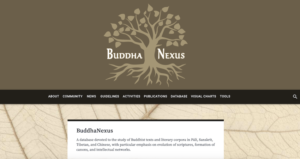Databases
Indoskript 2.0
Presentation: Indoskript 2.0 is a paleographic database of Brahmi and Kharosthi that aims at covering the full historical development of these two Indic scripts. Indoskript builds on the great paleographic monographs of Bühler and Dani and on numerous more specialized publications, but offers a higher degree of flexibility. While traditional printed works are static, Indoskript can be queried for different criteria such as historical time, place of origin, or phonetic restrictions. We are convinced that the built-in functions for filtering data and aggregating results facilitate paleographic research to a significant degree.
Link: http://www.indoskript.org
Corpus of the Inscriptions of Campā
Presentation: The Corpus of the Inscriptions of Campā is a publication of the École française d’Extrême-Orient, realized in collaboration with the Institute for the Study of the Ancient World at New York University. This project aims recover, preserve, study and make accessible the corpus of inscriptions of ancient Campā (in present Việt Nam), written either in Sanskrit or in Old Cam.
Link: https://isaw.nyu.edu/publications/inscriptions/campa/index.html
Early Inscriptions of Āndhradeśa
Presentation: This digital publication aims to present the complete primary textual data along with metadata, including precise information on the whereabouts of the inscribed artefacts, annotated English translations, for a major Indian epigraphic corpus that has so far only been studied with pre-digital methods. Our aim has been to identify in the field, or in museums, all inscriptions falling within our purview, to document them photographically, to re-edit them from the originals whenever possible, and to exploit the full potential of a digital corpus approach to these historical documents.
Initially focused on the inscriptions of Nagarjunakonda and the Ikṣvāku dynasty, on the one hand, and on post-Ikṣvāku documents for the history of Buddhism, on the other, the publication will eventually cover all records from the beginning of the epigraphic tradition in the part of India covered today by the states of Telangana and Andhra up to the rise of Telugu as epigraphical language of expression in the second half of the first millennium, as rough chronological cut-off point.
In this early period, the epigraphic corpus of Āndhradeśa is primarily connected with the history of Buddhism. Our work on this corpus began as part of a collaborative research project ‘From Vijayapuri to Sriksetra? The Beginnings of Buddhist Exchange across the Bay of Bengal as Witnessed by Inscriptions from Andhra Pradesh and Myanmar’, which investigated the history of Buddhism across the Bay of Bengal based on the epigraphic records of Vijayapuri (modern Nagarjunakonda) in India and Sriksetra (near modern Pyay) in Myanmar. See also Credits.
The data presented in this publication have been encoded in XML according to the EpiDoc schema compliant with the Text Encoding Initiative and processed through ODD in an eXist database.
Link: http://hisoma.huma-num.fr/exist/apps/EIAD/index2.html
BuddhaNexus
Presentation: BuddhaNexus is a powerful tool aimed at facilitating the study of the evolution of Buddhist scriptures and the formation of the various Buddhist canons by exploiting artificial neural networks in order to locate (approximate) textual matches. This project is conducted by: Khyentse Center (KC), Universität Hamburg (UHH), SuttaCentral, International Institute for Digital Humanities, Tokyo (DHII), Buddhist Digital Resource Center (BDRC), Resources for Kanjur & Tanjur Studies (rKTs, Universität Wien), Vipassana Research Institute (VRI), Asian Classics Input Projects (ACIP), Buddhist Digital Resource Center (BDRC), Göttingen Register of Electronic Texts in Indian Languages (GRETIL, Georg-August-Universität Göttingen), Digital Sanskrit Buddhist Canon (DSBC, University of the West), Chinese Buddhist Electronic Text Association (CBETA), Chinese Buddhist Canonical Attributions database (CBC@) by Michael Radich and Jamie Norrish.
Link: https://buddhanexus.net/




